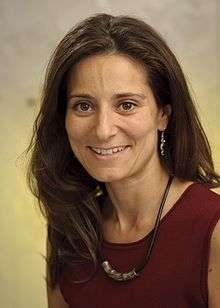Natalie Batalha

Natalie Batalha is a research astronomer in the Space Sciences Division of NASA Ames Research Center. She holds the position of Co-Investigator and Kepler Mission Scientist on the Kepler Mission, the first mission capable of finding Earth-size planets around other stars.[1][2][3]
Biography
Batalha began her career as a stellar spectroscopist, studying sun-like stars. She holds a bachelor's degree in physics from the University of California, Berkeley, a doctorate in astrophysics from UC Santa Cruz, and completed a post-doctoral fellowship in Rio de Janeiro, Brazil.[2]
Career
In 1997, William Borucki added Batalha to the science team and she started work on transit photometry. She has been involved with the Kepler Mission since the design and funding, and as one of the original Co-Investigators was responsible for the selection of the more than 150,000 stars monitored by the telescope. She now works closely with team members at Ames Research Center to identify viable planets from the data of the Kepler mission. She led the analysis that yielded the discovery in 2011 of Kepler 10b, the first confirmed rocky planet outside our solar system.[4]
In 2017, Batalha and two other exoplanet scientists were named to Time Magazine's 100 Most Influential People in the World.[5]
In 2017, Batalha won Smithsonian Magazine's American Ingenuity Award in Physical Sciences.[6]
References
- ↑ "Mission Scientist: Natalie Batalha". NASA. Archived from the original on September 15, 2015.
- 1 2 "Natalie Batalha". Space Science and Astrobiology at Ames. NASA. Archived from the original on September 23, 2015.
- ↑ "Natalie Batalha". Kepler. NASA: Ames Research Center. Archived from the original on September 21, 2015.
- ↑ Lemonick, Michael D (2012). Mirror Earth : the search for our planet's twin. New York: Walker. ISBN 978-0-8027-7900-7.
- ↑ Stern, Alan. "Natalie Batalha, Guillem Anglada-Escudé and Michaël Gillon". The World’s 100 Most Influential People. Time. Archived from the original on 2 May 2017.
- ↑ "2017 American Ingenuity Award Winners". Smithsonian Magazine. Smithsonian. Retrieved 11 October 2018.